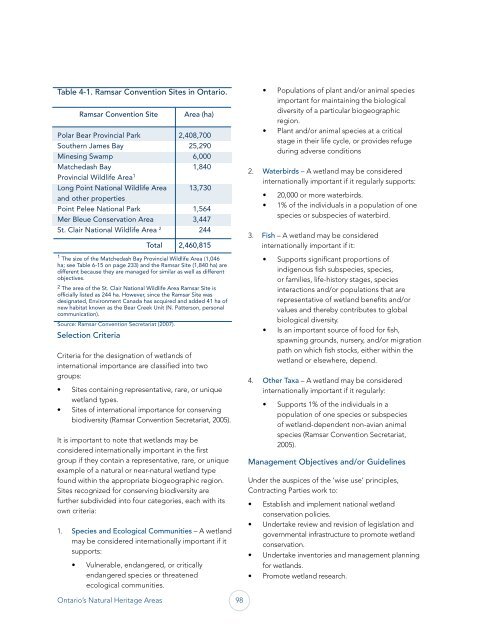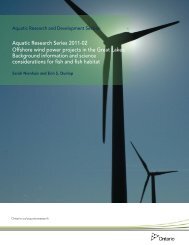Ontario's Natural Heritage Areas - Ministry of Natural Resources
Ontario's Natural Heritage Areas - Ministry of Natural Resources
Ontario's Natural Heritage Areas - Ministry of Natural Resources
Create successful ePaper yourself
Turn your PDF publications into a flip-book with our unique Google optimized e-Paper software.
Table 4-1. Ramsar Convention Sites in Ontario.<br />
Ramsar Convention Site Area (ha)<br />
Polar Bear Provincial Park 2,408,700<br />
Southern James Bay 25,290<br />
Minesing Swamp 6,000<br />
Matchedash Bay 1,840<br />
Provincial Wildlife Area 1<br />
Long Point National Wildlife Area 13,730<br />
and other properties<br />
Point Pelee National Park 1,564<br />
Mer Bleue Conservation Area 3,447<br />
St. Clair National Wildlife Area 2 244<br />
Selection Criteria<br />
Total 2,460,815<br />
1<br />
The size <strong>of</strong> the Matchedash Bay Provincial Wildlife Area (1,046<br />
ha; see Table 6-15 on page 233) and the Ramsar Site (1,840 ha) are<br />
different because they are managed for similar as well as different<br />
objectives.<br />
2 The area <strong>of</strong> the St. Clair National Wildlife Area Ramsar Site is<br />
<strong>of</strong>ficially listed as 244 ha. However, since the Ramsar Site was<br />
designated, Environment Canada has acquired and added 41 ha <strong>of</strong><br />
new habitat known as the Bear Creek Unit (N. Patterson, personal<br />
communication).<br />
Source: Ramsar Convention Secretariat (2007).<br />
Criteria for the designation <strong>of</strong> wetlands <strong>of</strong><br />
international importance are classified into two<br />
groups:<br />
• Sites containing representative, rare, or unique<br />
wetland types.<br />
• Sites <strong>of</strong> international importance for conserving<br />
biodiversity (Ramsar Convention Secretariat, 2005).<br />
It is important to note that wetlands may be<br />
considered internationally important in the first<br />
group if they contain a representative, rare, or unique<br />
example <strong>of</strong> a natural or near-natural wetland type<br />
found within the appropriate biogeographic region.<br />
Sites recognized for conserving biodiversity are<br />
further subdivided into four categories, each with its<br />
own criteria:<br />
1. Species and Ecological Communities – A wetland<br />
may be considered internationally important if it<br />
supports:<br />
• Vulnerable, endangered, or critically<br />
endangered species or threatened<br />
ecological communities.<br />
Ontario’s <strong>Natural</strong> <strong>Heritage</strong> <strong>Areas</strong> 98<br />
• Populations <strong>of</strong> plant and/or animal species<br />
important for maintaining the biological<br />
diversity <strong>of</strong> a particular biogeographic<br />
region.<br />
• Plant and/or animal species at a critical<br />
stage in their life cycle, or provides refuge<br />
during adverse conditions<br />
2. Waterbirds – A wetland may be considered<br />
internationally important if it regularly supports:<br />
• 20,000 or more waterbirds.<br />
• 1% <strong>of</strong> the individuals in a population <strong>of</strong> one<br />
species or subspecies <strong>of</strong> waterbird.<br />
3. Fish – A wetland may be considered<br />
internationally important if it:<br />
• Supports significant proportions <strong>of</strong><br />
indigenous fish subspecies, species,<br />
or families, life-history stages, species<br />
interactions and/or populations that are<br />
representative <strong>of</strong> wetland benefits and/or<br />
values and thereby contributes to global<br />
biological diversity.<br />
• Is an important source <strong>of</strong> food for fish,<br />
spawning grounds, nursery, and/or migration<br />
path on which fish stocks, either within the<br />
wetland or elsewhere, depend.<br />
4. Other Taxa – A wetland may be considered<br />
internationally important if it regularly:<br />
• Supports 1% <strong>of</strong> the individuals in a<br />
population <strong>of</strong> one species or subspecies<br />
<strong>of</strong> wetland-dependent non-avian animal<br />
species (Ramsar Convention Secretariat,<br />
2005).<br />
Management Objectives and/or Guidelines<br />
Under the auspices <strong>of</strong> the ‘wise use’ principles,<br />
Contracting Parties work to:<br />
• Establish and implement national wetland<br />
conservation policies.<br />
• Undertake review and revision <strong>of</strong> legislation and<br />
governmental infrastructure to promote wetland<br />
conservation.<br />
• Undertake inventories and management planning<br />
for wetlands.<br />
• Promote wetland research.

















